高三下学期英语周测试题2020.3
- 格式:pdf
- 大小:411.47 KB
- 文档页数:8
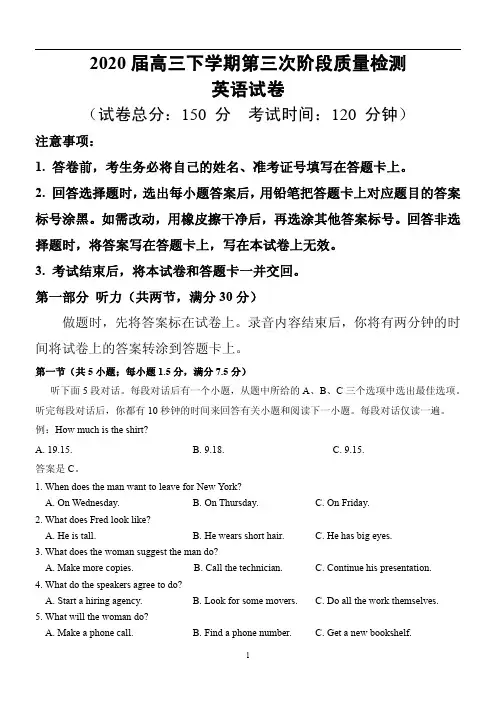
2020届高三下学期第三次阶段质量检测英语试卷(试卷总分:150分考试时间:120分钟)注意事项:1.答卷前,考生务必将自己的姓名、准考证号填写在答题卡上。
2.回答选择题时,选出每小题答案后,用铅笔把答题卡上对应题目的答案标号涂黑。
如需改动,用橡皮擦干净后,再选涂其他答案标号。
回答非选择题时,将答案写在答题卡上,写在本试卷上无效。
3.考试结束后,将本试卷和答题卡一并交回。
第一部分听力(共两节,满分30分)做题时,先将答案标在试卷上。
录音内容结束后,你将有两分钟的时间将试卷上的答案转涂到答题卡上。
第一节(共5小题;每小题1.5分,满分7.5分)听下面5段对话。
每段对话后有一个小题,从题中所给的A、B、C三个选项中选出最佳选项。
听完每段对话后,你都有10秒钟的时间来回答有关小题和阅读下一小题。
每段对话仅读一遍。
例:How much is the shirt?A.19.15.B.9.18.C.9.15.答案是C。
1.When does the man want to leave for New York?A.On Wednesday.B.On Thursday.C.On Friday.2.What does Fred look like?A.He is tall.B.He wears short hair.C.He has big eyes.3.What does the woman suggest the man do?A.Make more copies.B.Call the technician.C.Continue his presentation.4.What do the speakers agree to do?A.Start a hiring agency.B.Look for some movers.C.Do all the work themselves.5.What will the woman do?A.Make a phone call.B.Find a phone number.C.Get a new bookshelf.第二节(共15小题;每小题1.5分;满分22.5分)听下面5段对话或独白。
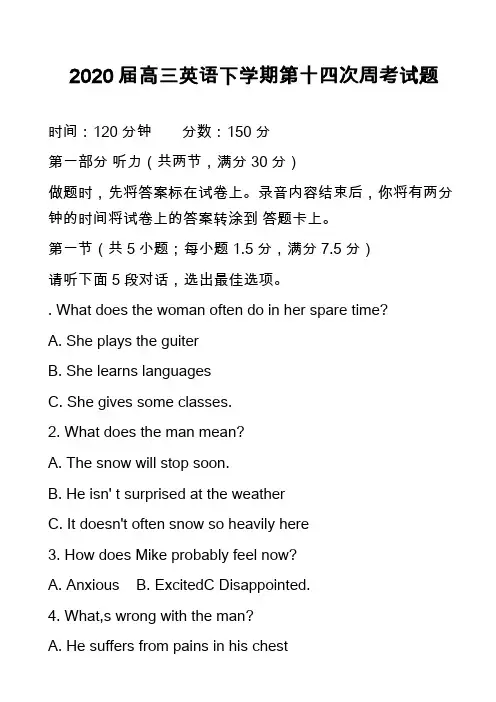
2020届高三英语下学期第十四次周考试题时间:120分钟分数:150分第一部分听力(共两节,满分30分)做题时,先将答案标在试卷上。
录音内容结束后,你将有两分钟的时间将试卷上的答案转涂到答题卡上。
第一节(共5小题;每小题1.5分,满分7.5分)请听下面5段对话,选出最佳选项。
. What does the woman often do in her spare time?A. She plays the guiterB. She learns languagesC. She gives some classes.2. What does the man mean?A. The snow will stop soon.B. He isn' t surprised at the weatherC. It doesn't often snow so heavily here3. How does Mike probably feel now?A. AnxiousB. ExcitedC Disappointed.4. What,s wrong with the man?A. He suffers from pains in his chestB.He has difficulty quitting smokingC.He has been coughing for ten days5. When did the man arrive here?A. At 4: 30 amB.At8:30 amC.At9:30 am第二节(共15小题; 每1.5分,满分22.5分)听下面5段对话或独白。
每段对话或独白后有几个小题,从题中所给的A、B、C三个选项中选出最佳选项,并标在试卷的相应位置。
听每段对话或独白前,你将有时间阅读各个小题,每小题5秒钟:听完后,各小题将给出5秒钟的作答时间。
每段对话或独自读两遍。
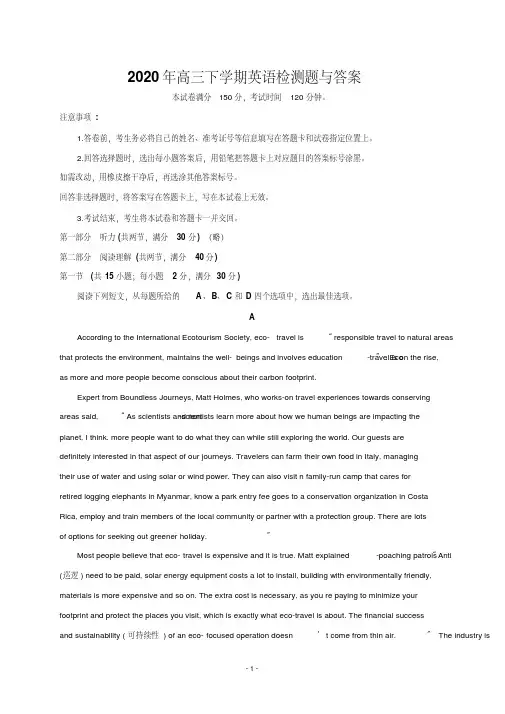
2020年高三下学期英语检测题与答案本试卷满分150分,考试时间120分钟。
注意事项:1.答卷前,考生务必将自己的姓名、准考证号等信息填写在答题卡和试卷指定位置上。
2.回答选择题时,选出每小题答案后,用铅笔把答题卡上对应题目的答案标号涂黑。
如需改动,用橡皮擦干净后,再选涂其他答案标号。
回答非选择题时,将答案写在答题卡上,写在本试卷上无效。
3.考试结束,考生将本试卷和答题卡一并交回。
第一部分听力(共两节,满分30分) (略)第二部分阅读理解(共两节,满分40分)第一节(共15小题;每小题2分,满分30分)阅读下列短文,从每题所给的A、B、C和D四个选项中,选出最佳选项。
AAccording to the International Ecotourism Society, eco-travel is “responsible travel to natural areas-travel is on the rise,that protects the environment, maintains the well-beings and involves education”. Ecoas more and more people become conscious about their carbon footprint.Expert from Boundless Journeys, Matt Holmes, who works-on travel experiences towards conserving-scientists learn more about how we human beings are impacting theareas said, “As scientists and nonplanet, I think. more people want to do what they can while still exploring the world. Our guests aredefinitely interested in that aspect of our journeys. Travelers can farm their own food in Italy, managingtheir use of water and using solar or wind power. They can also visit n family-run camp that cares forretired logging elephants in Myanmar, know a park entry fee goes to a conservation organization in CostaRica, employ and train members of the local community or partner with a protection group. There are lotsof options for seeking out greener holiday.”-poaching patrols Most people believe that eco-travel is expensive and it is true. Matt explained “Anti(巡逻) need to be paid, solar energy equipment costs a lot to install, building with environmentally friendly,materials is more expensive and so on. The extra cost is necessary, as you re paying to minimize yourfootprint and protect the places you visit, which is exactly what eco-travel is about. The financial successand sustainability (可持续性) of an eco- focused operation doesn’t come from thin air.” The industry istrying to make eco-travel affordable and make it accessible to the common people.1. What is the positive influence of eco-friendly travel?A. It enables travelers to protect the environment while travelingB. It keeps human beings healthy and happy in a friendly atmosphere.C. It teaches us to be responsible for the development of economy.D. It offers some valuable education about the knowledge of gardening.2. According to Matt Holmes, travelers will be interested in ________.A. eating delicious food in ItalyB. visiting elephants in the zooC. working together with a protection groupD. raising park entry fee in Costa Rica3. What will probably be talked about in the next paragraph of the passage?A. Why eco-travel is expensive.B. How we can make eco-travel less expensive.C. What material are used in eco-travel.D. Where we can go for eco-travel.BScience is finaly beginning to embrace animals who were, for a long time, considered second-class citizens.As Annie Potts of Canterbury University has noted, chickens distinguish among one hundred chicken faces and recognize familiar individuals even after months of separation. When given problems to solve,they reason: hens trained to pick colored buttons sometimes choose to give up an immediate food rewardfor a slightly later (and better) one. Healthy hens may aid friends, and mourn when those friend die.Pigs respond meaningful to human symbols. When a research team led by Candace Croney at Penn State University carried wooden blocks marked with X and O symbols around pigs, only the O carriers offered food to the animals. The pigs soon ignored the X carriers in favor of the O's. Then the teamswitched from real-life objects to T-shirts printed with X or O symbols. Still, the pigs walked only towardthe O-shirted people: they had transferred their knowledge to a two-dimensional format, a not inconsiderable feat of reasoning.I’ve been guilty of prejudiced expectations, myself. At the start of my career almost four decades ago, I was firmly convinced that monkeys and apes out-think and out-feel other animals. They're otherprimates(灵长目动物), after all, animals from our own mammalian(哺乳动物的) class. Fairly soon, I cameto see that along with our closest living relatives, whales too are masters of cultural learning, and elephantsexpress profound joy and mourning with their social companions. Long-term studies in the wild on thesemammals helped to fuel a viewpoint shift in our society: the public no longer so easily accepts monkeysmade to undergo painful procedure kin laboratories, elephants forced to perform in circuses, and dolphinskept in small tanks at theme parks.Over time, though, as I began to broaden out even further and explore the inner lives of fish, chickens,pigs, goats, and cows, I started to wonder: Will the new science of "food animals" bring an ethical (伦理的)revolution in terms of who we eat? In other words, will our ethics start to catch up with the development ofour science?Animal activists are already there, of course, committed to not eating these animals. But what aboutthe rest of us? Can paying attention to the thinking and feeling of these animals lead us to make changes inwho we eat?4. According to Annie Potts, hens have the ability of_____________.A. interactionB. analysisC. creationD. abstraction5. The research into pigs shows that pigs___________.A. learn letters quicklyB. have a good eyesightC. can build up a good relationshipD. can apply knowledge to new situations6. Paragraph 4 is mainly about________.A. the similarities between mammals and humansB. the necessity of long-term studies on mammalsC. a change in people's attitudes towards animalsD. a discovery of how animals express themselves7. What might be the best title for the passage?A. The Inner Lives of Food AnimalsB. The Lifestyles of Food AnimalsC. Science Reports on Food AnimalsD. A Revolution in Food AnimalsCWhy does time seem to fly by faster as we get old? You've got your aging brain to blame. This is likelydue largely to the physical changes of our nerves and neurons(神经元). New research suggests ‘rapid fire’ abilities of the young brain allow us to process more information during youth, causing the days to seemlonger earlier in life. However, as we get old, researchers say the older brain takes more time to processinformation.The new finding put forward by a Duke University researcher was published in a paper in the journalEuropean Review this week According to Adrian Bejan, the J. A Jones Professor of MechanicalEngineering at Duke, the physical changes of our nerves and neurons play, a major role in ourperception(知觉) of time as we get old. Over the years these structures become more complex andeventually begin to degrade."Little babies, for example, move their eyes much more often than adults because they’re images at a faster rate, "Beian says, For older people, this means fewer images are being processed in thesame amount of time, causing experiences to seem as though they’re happening more quickly.8. What causes time to fly faster as we get old?A. Changes of our nerves and neurons.B. Information in our brain .C. The electrical signals.D. Rapid fire abilities.9. What is unavoidable in the process of getting old?A. Longer days.B. Aging brains.C. More images.D. Less experience.10. Why do the days seem longer earlier in life?A. Young people are more energetic in their life.B. The younger brain takes less time to process informationC. Old people have fewer things to do than young people.D. Little babies move their eyes much more often.11. What is the best title of the text?A. Nerves and NeuronsB. Time Flies FastC. The Older, the FasterD. The Function of the BrainDHONG KONG-Cross-border buses operated by Hong Kong companies on Friday started trial runs onthe Hong Kong-Zhuhai-Macao Bridge (HZMB) in preparation for the bridge’s upcoming opening.“The trial runs, arranged by the governments of the Chinese mainland, the Hong Kong SpecialAdministrative Region (SAR) and the Macao SAR, would last for three days and aimed at testing thereadiness of boundary crossing facilities (设施) of the three places,” the Hong Kong SAR government’sTransport and Housing Bureau told Xinhua.Two major cross-boundary coach trade associations in Hong Kong were invited to send buses andmembers to participate in the trial runs.Freeman Cheung, secretary of Hong Kong Guangdong Boundary Crossing Bus Association, said hisassociation would run one bus with about 10 passengers on Friday and Saturday respectively as part of thetrial runs.“Our bus started at noon from the Hong Kong Boundary Crossing Facilities and ran all the way toZhuhai in about 40 minutes,” he said, adding that “the journey was smooth.”Alan Chan, secretary of another trade association who participated in the trial runs as a passenger, saidthe clearance procedures at boundary crossing facilities of the three places all went on well and smoothly.“The boundary crossing facilities of Zhuhai and Macao, in particular, are operated in a collaborative(合作的) way, which helps remarkably shorten the time needed for the clearance procedures,” h The HZMB, situated at the waters of Lingdingyang of Pearl River Estuary, is a mega-size sea crossinglinking the Hong Kong SAR, Zhuhai city of Guangdong Province and the Macao SAR.The 55-km bridge is the longest bridge-and-tunnel (隧道) sea crossing in the world.The bridge is meant to meet the demand of passenger and freight land transport among Hong Kong,the Chinese mainland and Macao, and to establish a new land transport link between the east and westbanks of the Pearl River.12. We learn from the passage that ________.A. Alan Chan participated in the trial runs as a driverB. two coach trade associations in Zhuhai took part in the trial runsC. the HZMB is located at the waters of Lingdingyang of Pearl River EstuaryD. the 55-km bridge is the second longest bridge-and-tunnel sea crossing in the world13. What is the main idea of the second paragraph?A. The route of the trial runs.B. The effect of the trial runs.C. The purpose of the trial runs.D. The evaluation of the trial runs.14. What does the underlined word “freight” in the last paragraph mean?A. Goods that are transported by trucks, trains, ships, or planes.B. Lines of raised water that moves across the surface of the sea.C. Parts of the sea where fish are caught in large numbers.D. The regular rising and falling of the level of the sea.15. Which of the following can be the best title for the news report?A. HZMB Is to Establish New Land Transport LinkB. Cross-border Buses Start Trial Runs on Hong Kong-Zhuhai-Macao BridgeC. Mega-size Sea Crossing Linking Hong Kong SAR, Zhuhai and Macao SARD. Boundary Crossing Facilities of Zhuhai and Macao Operated Collaboratively第二节(共5小题;每小题2分,满分10分)根据短文内容,从短文后的选项中选出能填入空白处的最佳选项。
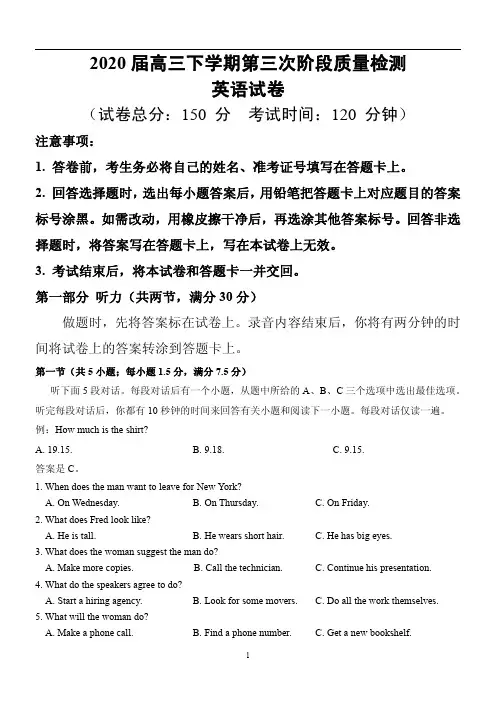
2020届高三下学期第三次阶段质量检测英语试卷(试卷总分:150分考试时间:120分钟)注意事项:1.答卷前,考生务必将自己的姓名、准考证号填写在答题卡上。
2.回答选择题时,选出每小题答案后,用铅笔把答题卡上对应题目的答案标号涂黑。
如需改动,用橡皮擦干净后,再选涂其他答案标号。
回答非选择题时,将答案写在答题卡上,写在本试卷上无效。
3.考试结束后,将本试卷和答题卡一并交回。
第一部分听力(共两节,满分30分)做题时,先将答案标在试卷上。
录音内容结束后,你将有两分钟的时间将试卷上的答案转涂到答题卡上。
第一节(共5小题;每小题1.5分,满分7.5分)听下面5段对话。
每段对话后有一个小题,从题中所给的A、B、C三个选项中选出最佳选项。
听完每段对话后,你都有10秒钟的时间来回答有关小题和阅读下一小题。
每段对话仅读一遍。
例:How much is the shirt?A.19.15.B.9.18.C.9.15.答案是C。
1.When does the man want to leave for New York?A.On Wednesday.B.On Thursday.C.On Friday.2.What does Fred look like?A.He is tall.B.He wears short hair.C.He has big eyes.3.What does the woman suggest the man do?A.Make more copies.B.Call the technician.C.Continue his presentation.4.What do the speakers agree to do?A.Start a hiring agency.B.Look for some movers.C.Do all the work themselves.5.What will the woman do?A.Make a phone call.B.Find a phone number.C.Get a new bookshelf.第二节(共15小题;每小题1.5分;满分22.5分)听下面5段对话或独白。
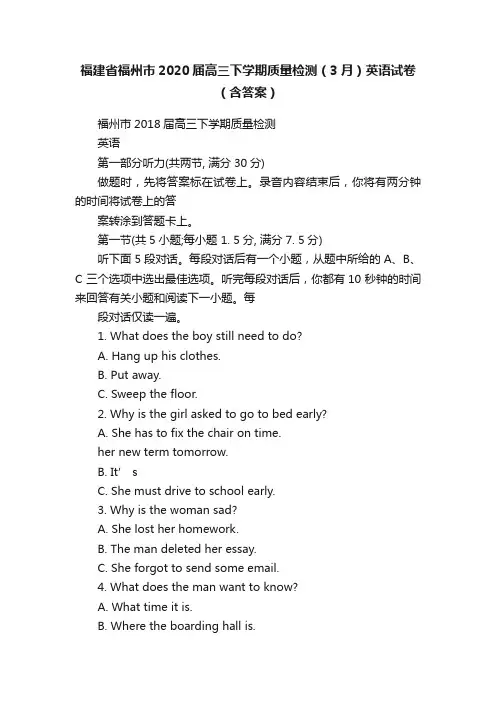
福建省福州市2020届高三下学期质量检测(3月)英语试卷(含答案)福州市2018届高三下学期质量检测英语第一部分听力(共两节, 满分30分)做题时,先将答案标在试卷上。
录音内容结束后,你将有两分钟的时间将试卷上的答案转涂到答题卡上。
第一节(共5小题;每小题 1. 5分, 满分7. 5分)听下面5段对话。
每段对话后有一个小题,从题中所给的A、B、C 三个选项中选出最佳选项。
听完每段对话后,你都有10 秒钟的时间来回答有关小题和阅读下一小题。
每段对话仅读一遍。
1. What does the boy still need to do?A. Hang up his clothes.B. Put away.C. Sweep the floor.2. Why is the girl asked to go to bed early?A. She has to fix the chair on time.her new term tomorrow.B. It’sC. She must drive to school early.3. Why is the woman sad?A. She lost her homework.B. The man deleted her essay.C. She forgot to send some email.4. What does the man want to know?A. What time it is.B. Where the boarding hall is.C. When his train is supposed to leave.5. Who might Freddy be?A. The speakers’son. B. The speakers’ pet. C. The speakers’ landlord.第二节(共15小题:每小题 1. 5分,满分22. 5分)听下面5段对话或独白。
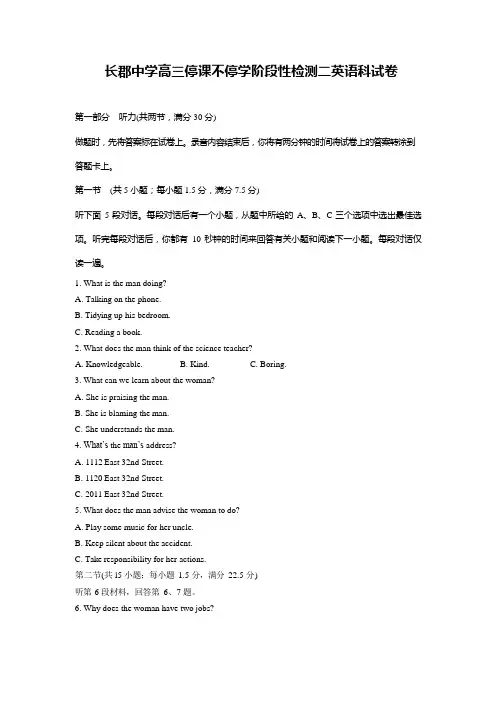
长郡中学高三停课不停学阶段性检测二英语科试卷第一部分听力(共两节,满分30 分)做题时,先将答案标在试卷上。
录音内容结束后,你将有两分钟的时间将试卷上的答案转涂到答题卡上。
第一节(共5 小题;每小题1.5 分,满分7.5 分)听下面5 段对话。
每段对话后有一个小题,从题中所给的A、B、C 三个选项中选出最佳选项。
听完每段对话后,你都有10 秒钟的时间来回答有关小题和阅读下一小题。
每段对话仅读一遍。
1.What is the man doing?A.Talking on the phone.B.Tidying up his bedroom.C.Reading a book.2.What does the man think of the science teacher?A. Knowledgeable.B. Kind.C. Boring.3.What can we learn about the woman?A.She is praising the man.B.She is blaming the man.C.She understands the man.4.What’s the man’s address?A.1112 East 32nd Street.B.1120 East 32nd Street.C.2011 East 32nd Street.5.What does the man advise the woman to do?A.Play some music for her uncle.B.Keep silent about the accident.C.Take responsibility for her actions.第二节(共l5 小题;每小题1.5 分,满分22.5 分)听第6 段材料,回答第6、7 题。
6.Why does the woman have two jobs?A.To support her parents.B.To save up for her trip.C.To pay her tuition fees.7.What do we know about the man?A.He just came back from Australia.B.He will graduate next month.C.He hasn’t had a job for two years.听第7 段材料,回答第8 至10 题。
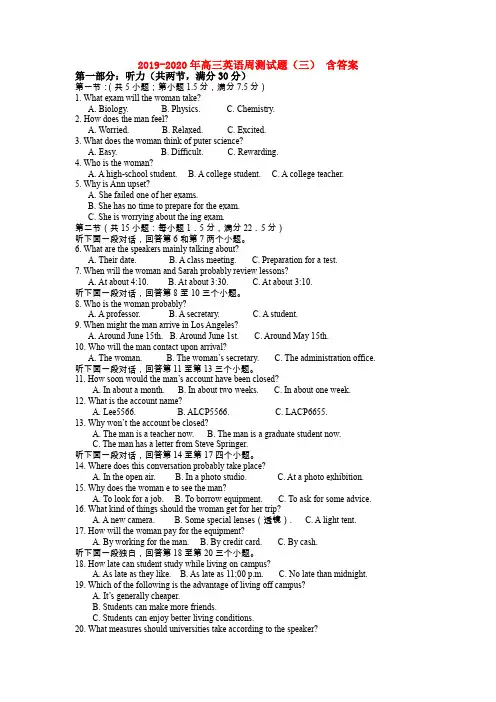
2019-2020年高三英语周测试题(三)含答案第一部分:听力(共两节,满分30分)第一节:(共5小题;第小题1.5分,满分7.5分)1. What exam will the woman take?A. Biology.B. Physics.C. Chemistry.2. How does the man feel?A. Worried.B. Relaxed.C. Excited.3. What does the woman think of puter science?A. Easy.B. Difficult.C. Rewarding.4. Who is the woman?A. A high-school student.B. A college student.C. A college teacher.5. Why is Ann upset?A. She failed one of her exams.B. She has no time to prepare for the exam.C. She is worrying about the ing exam.第二节(共15小题:每小题1.5分,满分22.5分)听下面一段对话,回答第6和第7两个小题。
6. What are the speakers mainly talking about?A. Their date.B. A class meeting.C. Preparation for a test.7. When will the woman and Sarah probably review lessons?A. At about 4:10.B. At about 3:30.C. At about 3:10.听下面一段对话,回答第8至10三个小题。
8. Who is the woman probably?A. A professor.B. A secretary.C. A student.9. When might the man arrive in Los Angeles?A. Around June 15th.B. Around June 1st.C. Around May 15th.10. Who will the man contact upon arrival?A. The woman.B. The woman’s secretary.C. The administration office. 听下面一段对话,回答第11至第13三个小题。
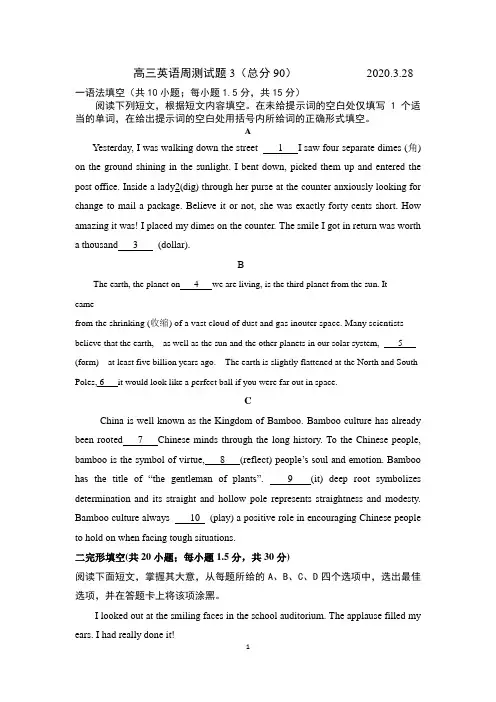
高三英语周测试题3(总分90)2020.3.28一语法填空(共10小题;每小题1.5分,共15分)阅读下列短文,根据短文内容填空。
在未给提示词的空白处仅填写 1个适当的单词,在给出提示词的空白处用括号内所给词的正确形式填空。
AYesterday, I was walking down the street 1 I saw four separate dimes (角) on the ground shining in the sunlight. I bent down, picked them up and entered the post office. Inside a lady2(dig) through her purse at the counter anxiously looking for change to mail a package. Believe it or not, she was exactly forty cents short. How amazing it was! I placed my dimes on the counter. The smile I got in return was worth a thousand 3 (dollar).BThe earth, the planet on 4 we are living, is the third planet from the sun. Itcamefrom the shrinking (收缩) of a vast cloud of dust and gas inouter space. Many scientists believe that the earth, as well as the sun and the other planets in our solar system, 5 (form) at least five billion years ago. The earth is slightly flattened at the North and South Poles, 6 it would look like a perfect ball if you were far out in space.CChina is well known as the Kingdom of Bamboo. Bamboo culture has already been rooted 7 Chinese minds through the long history. To the Chinese people, bamboo is the symbol of virtue, 8 (reflect) people’s soul and emotion. Bamboo has the title of “the gentleman of plants”. 9 (it) deep root symbolizes determination and its straight and hollow pole represents straightness and modesty. Bamboo culture always 10 (play) a positive role in encouraging Chinese people to hold on when facing tough situations.二完形填空(共20小题;每小题1.5分,共30分)阅读下面短文,掌握其大意,从每题所给的A、B、C、D四个选项中,选出最佳选项,并在答题卡上将该项涂黑。
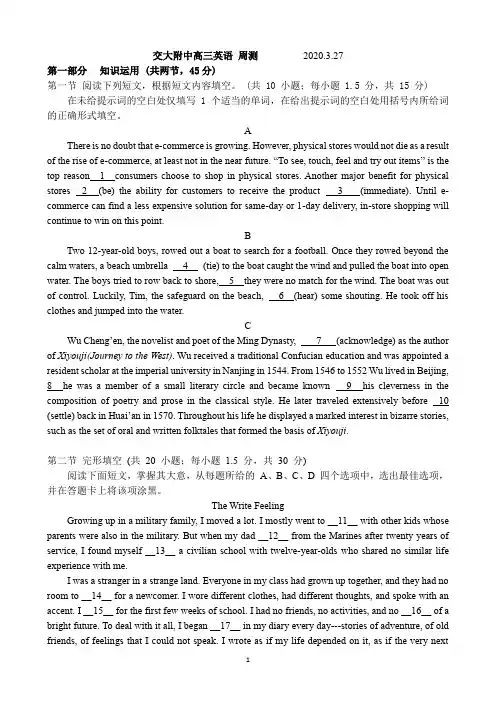
交大附中高三英语周测2020.3.27第一部分知识运用 (共两节,45分)第一节阅读下列短文,根据短文内容填空。
(共 10 小题;每小题 1.5 分,共 15 分) 在未给提示词的空白处仅填写1个适当的单词,在给出提示词的空白处用括号内所给词的正确形式填空。
AThere is no doubt that e-commerce is growing. However, physical stores would not die as a result of the rise of e-commerce, at least not in the near future. “To see, touch, feel and try out items” is the top reason 1 consumers choose to shop in physical stores. Another major benefit for physical stores 2 (be) the ability for customers to receive the product 3 (immediate). Until e-commerce can find a less expensive solution for same-day or 1-day delivery, in-store shopping will continue to win on this point.BTwo 12-year-old boys, rowed out a boat to search for a football. Once they rowed beyond the calm waters, a beach umbrella 4 (tie) to the boat caught the wind and pulled the boat into open water. The boys tried to row back to shore, 5 they were no match for the wind. The boat was out of control. Luckily, Tim, the safeguard on the beach, 6 (hear) some shouting. He took off his clothes and jumped into the water.CWu Cheng’en, the novelist and poet of the Ming Dynasty, 7 (acknowledge) as the author of Xiyouji(Journey to the West). Wu received a traditional Confucian education and was appointed a resident scholar at the imperial university in Nanjing in 1544. From 1546 to 1552 Wu lived in Beijing, 8 he was a member of a small literary circle and became known 9 his cleverness in the composition of poetry and prose in the classical style. He later traveled extensively before 10 (settle) back in Huai’an in 1570. Throughout his life he displayed a marked interest in bizarre stories, such as the set of oral and written folktales that formed the basis of Xiyouji.第二节完形填空(共20 小题;每小题 1.5 分,共30 分)阅读下面短文,掌握其大意,从每题所给的A、B、C、D 四个选项中,选出最佳选项,并在答题卡上将该项涂黑。
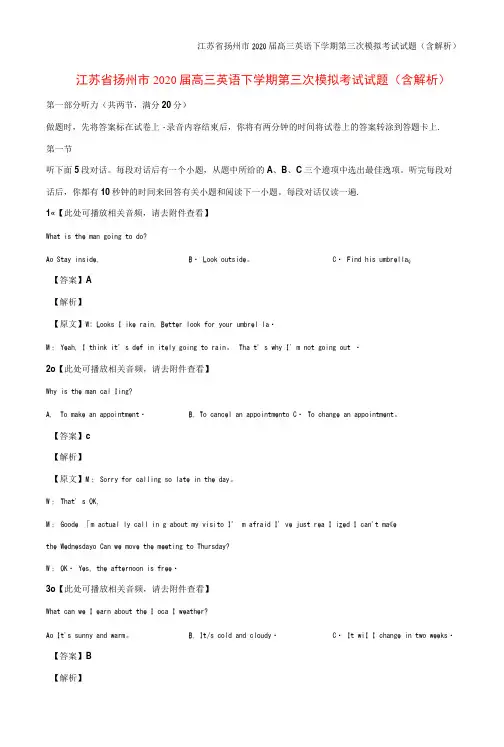
江苏省扬州市2020届髙三英语下学期第三次模拟考试试题(含解析)江苏省扬州市2020届高三英语下学期第三次模拟考试试题(含解析)第一部分听力(共两节,满分20分)做题时,先将答案标在试卷上・录音内容结東后,你将有两分钟的时间将试卷上的答案转涂到答题卡上.第一节听下面5段对话。
每段对话后有一个小题,从題中所给的A、B、C三个遶项中选出最佳逸项。
听完每段对话后,你都有10秒钟的时间来回答有关小题和阅读下一小题。
每段对话仅读一遍.1«【此处可播放相关音频,请去附件查看】What is the man going to do?Ao Stay inside. B・ Look outside。
C・ Find his umbrella0【答案】A【解析】【原文】W: Looks I ike rain. Better look for your umbrel la・M: Yeah, I think it' s def in itely going to rain。
Tha t' s why I' m not going out ・2o【此处可播放相关音频,请去附件查看】Why is the man cal Iing?A.To make an appointment・B. To cancel an appointmento C・ To change an appointment。
【答案】c【解析】【原文】M: Sorry for calling so late in the day。
W: That' s OK.M: Goode 「m actual ly call in g about my visito I’ m afraid I' ve just rea I ized I can't ma«ethe Wednesdayo Can we move the meeting to Thursday?W: 0K・ Yes, the afternoon is free・3o【此处可播放相关音频,请去附件查看】What can we I earn about the I oca I weather?Ao It's sunny and warm。

高三英语周测试题3(总分90)2020.3.28一语法填空(共10小题;每小题1.5分,共15分)阅读下列短文,根据短文内容填空。
在未给提示词的空白处仅填写 1个适当的单词,在给出提示词的空白处用括号内所给词的正确形式填空。
AYesterday, I was walking down the street 1 I saw four separate dimes (角) on the ground shining in the sunlight. I bent down, picked them up and entered the post office. Inside a lady2(dig) through her purse at the counter anxiously looking for change to mail a package. Believe it or not, she was exactly forty cents short. How amazing it was! I placed my dimes on the counter. The smile I got in return was worth a thousand 3 (dollar).BThe earth, the planet on 4 we are living, is the third planet from the sun. Itcamefrom the shrinking (收缩) of a vast cloud of dust and gas inouter space. Many scientists believe that the earth, as well as the sun and the other planets in our solar system, 5 (form) at least five billion years ago. The earth is slightly flattened at the North and South Poles, 6 it would look like a perfect ball if you were far out in space.CChina is well known as the Kingdom of Bamboo. Bamboo culture has already been rooted 7 Chinese minds through the long history. To the Chinese people, bamboo is the symbol of virtue, 8 (reflect) people’s soul and emotion. Bamboo has the title of “the gentleman of plants”. 9 (it) deep root symbolizes determination and its straight and hollow pole represents straightness and modesty. Bamboo culture always 10 (play) a positive role in encouraging Chinese people to hold on when facing tough situations.二完形填空(共20小题;每小题1.5分,共30分)阅读下面短文,掌握其大意,从每题所给的A、B、C、D四个选项中,选出最佳选项,并在答题卡上将该项涂黑。
山东省2020届高三英语模拟卷三(含解析)注意事项:1. 答卷前,考生务必将自己的姓名、考生号等填写在答题卡和试卷指定位置上。
2. 回答选择题时,选出每小题答案后,用铅笔把答题卡上对应题目的答案标号涂黑。
如需改动,用橡皮擦干净后,再选涂其他答案标号。
回答非选择题时,将答案写在答题卡上。
写在本试卷上无效。
3. 考试结束后,将本试卷和答题卡一并交回。
第一部分阅读(共两节,满分50分)第一节(共15小题;每小题2. 5分,满分37. 5分)阅读下列短文,从每题所给的A、B、C、D四个选项中选出最佳选项。
ATWO NEWS REPORTSNEWS REPORT 1Even before 5G is widely commercially available, Chinese telecom giant Huawei has reportedly begun researching the next generation of wireless technology—6G.Tech website “iPhone in Canada” reported that Huawei has con firmed to local media “The Logic (逻辑学;逻辑性)” that it has started researching 6G technology at its lab in Ottawa, Canada and “is in talks with Canadian university researchers about working on development of the next-generation wireless system,” citing a repo rt by The Logic.Song Zhang, vice-president of research strategy and partnership of Huawei in Canada, said “5G is very new, and looking at 6G is part of the so-called 5G evolution.”Huawei has not commented on the report, according to The Paper.NEWS REPORT 2A Japanese startup called SkyDrive Inc. has begun conducting test flights of their prototype flying car with a human pilot.The company hopes to be able to make a full public demonstration (演示;展示) of the vehicle later this summer.The test flights are being conducted at a protected indoor facility at thecompany’s research flight center outside of Nagoya.There have been a number of previous test flights, but they were all conducted via remote control and no human pilot on-board.According to a report in The Asahi Shimbun, SkyDrive says the car could be ready for a limited retail release as early as 2023, and mass production by 2026.SkyDrive was founded by former engineers from Toyota and they intend their vehicle to be the world’s smallest flying car.In 2017, Toyota gave the company an infusion (灌输) of around $ 350,000 to help develop flying vehicles.The company said it won’t say more about how the test flights have been proceeding (行动;进行) so far, but says things are going well enough to continue making them.1. What we can learn from NEWS REPORT 1?A. Huawei and Apple cooperate to develop 6G technology.B. Huawei is the first company to study 6G technology.C. Huawei’s research team studies 6G technology in Canadian laboratories.D. Huawei is not optimistic about the prospects of 6G.2. Which of the following is NOT true about NEWS REPORT 2?A. The company hopes to have an opportunity to make a full public demonstration of the vehicle.B. Previous flight tests were controlled by remote control.C. The car may not be able to mass produce in the near future.D. The car was completely invented and produced by Toyota.3. Which news section are we likely to see these two news reports?A. Entertainment.B. Science and Technology.C. Story.D. History.【答案】1. C 2. D 3. B【解析】本文是一篇说明文。
江苏省扬州市2020届高三英语下学期第三次模拟考试试题(含解析)第一部分听力(共两节, 满分 20 分)做题时, 先将答案标在试卷上。
录音内容结束后, 你将有两分钟的时间将试卷上的答案转涂到答题卡上。
第一节听下面5段对话。
每段对话后有一个小题,从题中所给的A、B、C三个选项中选出最佳选项。
听完每段对话后,你都有10秒钟的时间来回答有关小题和阅读下一小题。
每段对话仅读一遍。
1.【此处可播放相关音频,请去附件查看】What is the man going to do?A. Stay inside.B. Look outside.C. Find his umbrella.【答案】A【解析】【原文】W: Looks like rain. Better look for your umbrella.M: Yeah, I think it’s definitely going to rain. That’s why I’m not going out. 2.【此处可播放相关音频,请去附件查看】Why is the man calling?A. To make an appointment.B. To cancel an appointment.C. To change an appointment.【答案】C【解析】【原文】M: Sorry for calling so late in the day.W: That’s OK.M: Good. I’m actually calling about my visit. I’m afraid I’ve just realized I can’t make the Wednesday. Can we move the meeting to Thursday?W: OK. Yes, the afternoon is free.3.【此处可播放相关音频,请去附件查看】What can we learn about the local weather?A. It’s sunny and warm.B. It’s cold and cloudy.C. It will change intwo weeks.【答案】B【解析】【原文】W: I’ve got a two-week break coming up, and I’d like to go somewhere that’s hot and sunny.M: Hot and sunny? So you’re tired of our weather.4.【此处可播放相关音频,请去附件查看】When will the speakers meet?A. On January 30th.B. On January 31st.C. On February 1st. 【答案】C【解析】【原文】M: So when shall we meet?W: Let’s see. My trip begins on the 30th of January. That’s a Monday. How about Tuesday?M: I’d prefer the Wednesday.W: OK. That suits me.5.【此处可播放相关音频,请去附件查看】What will the woman probably do?A. Accept the man’s offer.B. Walk home.C. Give the man a ride.【答案】B【解析】【原文】M: Need a ride home?W: Thanks but my apartment is just around the corner. Besides, I need the fresh air. 第二节听下面5段对话或独白。
高三下学期第五次周测英语试题(3. 15)命题:孝文豪审题:刘安耿艳秋第一部分阅读(共两节, 满分50分)第一节(共15小题;每小题2. 5分, 满分37. 5分)阅读下列短文, 从每题所给的A、B、C、D四个选项中选出最佳选项。
AIf you’re looking to buy a gift for your children, why not keep up with the trend and get the best hoverboard?What is a Hoverboard?A hoverboard is a two-wheeled personal transportation device. It’s electrical, portable and became highly popular in 2015 in reference to a popular 1980’s movie. Typically, this self-balancing device operates like a powered skateboard.How Does a Hoverboard Work?The device may have many designs, but the mechanism itsel f isn’tcomplicated.Basically, a standard hoverboard contains:•Battery:stores the electrical power. Almost all hoverboards use a high-watt lithium-ion battery.•Gyroscope (one for each wheel):allows riders to tilt (倾斜)the hoverboard while maintaining balance and adjusting their direction.•Motor (one in each wheel): provides the power to the wheels to keep the rider balanced and upright.•Logic board: functions as the hoverboard brain. It processes data—your speed, tilt, etc.—and sends information to the motors. This unit controls the power of the board so riders can adjust their speed.All the above components work together to control the power and tilt of the hoverboards so the rider is balanced, upright and moving at a controlled speed.Why Buy a Hoverboard?Undoubtedly, hoverboards are cool. You’ve probably seen kids riding one around the house. They’re a phenomenon and everybody wants in. So, why deny your kids and prevent them from being part of this trend?Where is a hoverboard legal?Despite their wild popularity, hoverboards have yet to become “street-legal”. Currently, some places prohibit anyone under 16 from using these devices, and hoverboards are banned in academic institutions and public places, like campus buildings, parks, shopping malls and subway stations. Some places have also put speed limits on the devices and restricted their use to bike paths. However, open areas—including your yard—are free of these restrictions.1. The logic board of a hoverboard can _______.A. store electricityB. power the wheelsC. send information to the ridersD. receive data and give command2. According to the passage, a hoverboard can be used _______.A. on campusB. in parksC. on bike pathsD. in shopping malls3. What is the main purpose of this passage?A. To evaluate a gift’s quality.B. To recommend a gift choice.C. To compare new hoverboard models.D. To clarify functions of the latest hoverboards.BGrowing up, Deka Ismail says she let labels define what she could be. “I was a black girl, from a refugee(难民)family,”Deka said. “It was as if I was only allowed to explore in this predetermined box.”After a high school chemistry class inspired her to think about a career in science and gave her confidence in the field, Deka learned to live outside labels and began making big plans for her future. Now she is about to begin her freshman year at the University of California, planning to become a professor.Born and raised in San Diego’s City Heights neighbourhood, Deka is the daughter of a Somali refugee couple. While some might say Deka’s success happened in spite of her background, she would say differently, that her experiences shaped her and inspired her to be the driven, young scientist that she is today.When Deka was eight years old, her mother got a job by studying hard back in school in order to support the whole family. That made Deka realize that education could make a difference to one’s life. She spent a lot of time in the library reading books, and didn’t do many of the things her peers did, like partying or having romantic relationships.“I always felt like I had to be the perfect girl for my family,” Deka said. “You have to not even do your best but two times better than everyone else. I felt like the whole world was waiting for me to mess up.”Deka’s efforts paid off. The summer before her senior year of high school, she was accepted to the American Chemical Society Project SEED Programme. “She brought both enthusiasm and focus,” Botham, a researcher at this research institute, recalled. “She arrived every day ready to work, ready to learn and ready to tackle new challenges regardless of whether or not she had done anything similar.”When asked what advice she would give to others like her, Deka warned them not to underestimate themselves. “Don’t tell yourself that scholarship is too big or this programme is too competitive or I’ll never get i nto this school,” she said. “I was not sure whether I could make it untilI started seeing the acceptance letters rolling in.”4. From the passage, we can learn that _______.A. Deka was adopted by a refugee familyB. Deka spent a lot of time going to partiesC. Deka became a professor after graduationD. Deka’s experiences drove her to work hard5. Deka realized the importance of education _______.A. from her mother’s experienceB. after her chemistry classC. by reading books in the libraryD. through working at the institute6. According to the last paragraph, Deka advised that students be _______.A. patientB. confidentC. ambitiousD. generous7. What does the story intend to tell us?A. Life is not all roses.B. Practice makes perfect.C. Well begun is half done.D. Hard work leads to success.CA group of blue-faced birds step through the grass shoulder to shoulder, red eyes looking around. They look like middle schoolers seeking a cafeteria table at lunchtime. Perhaps they’re not so different.A new study, led by Damien Farine, an ornithologist who studies collective behaviour, shows that the vulturine guinea fowl of eastern Africa, like humans, have multilevel societies. In the past, scientists assumed such social structures required a lot of brainpower. But the pea-brained guinea fowl are revealing the faults in that assumption.These large birds wander across the landscape in packs, often walking so closely that their bodies touch. They may fight each other to maintain their strict hierarchies (等级制度), but at other times they engage in friendly behaviours like sharing food.Suspecting the guinea fowl might have a social structure, Dr. Farine and his colleagues began a thorough study of their society. For a whole year, they made daily observations of 441 birds. Coloured leg bands in unique combinations let researchers tell the black-and-blue birds apart. They also attached GPS devices to the backs of 58 birds, which let them see exactly where every group went, 24 hours a day.The findings of the research suggest that the vulturine guinea fowl have a multilevel society. There are groups within groups within the population as a whole. There even seem to be groups of friends within the small groups. This is the first time anyone has observed such a society in a bird. And Dr. Farine emphasizes this particular bird’s tiny brain size: “They don’t only have small brains relative to mammals, they also have quite small brains relative to other birds,” he said.According to him, living in this kind of society might actually make it easier to keep track of the social order. For example, if groups are stable and a bird can identify just one or two individuals within a group, it knows which group it’s looking at—no need for a brain that can recognize every single animal. Multilevel societies also let animals adjust their group sizes based on whatever challenges they’re facing. Depending on what enemies or resources are around, it might make sense to travel in a combined group rather than a smaller one.“Having a multilevel structure may not require having a large brain,” Dr. Farine said. There may be more birds and other animals out there that, although small-brained, have societies as many-leveled as our own.8. According to the passage, what inspired Dr. Farine to carry out the study?A. The guinea fowl’s social behaviour.B. Previous assumptions about birds.C. His interest in animal brainpower.D. The faults in earlier research.9. What is Paragraph 4 mainly about?A. The research subjects.B. The research methods.C. The research findings.D. The research equipment.10. What can be learned from the passage?A. Complex social systems can be a disadvantage to the guinea fowl.B. The guineafowl are good at recognizing individuals in a group.C. Birds maintain social order by travelling in combined groups.D. Small-brained animals can form multilevel societies.11. What is the main purpose of the passage?A. To present the findings of a study of the guinea fowl.B. To explain the interaction patterns in multilevel societies.C. To introduce a new approach to observing the guinea fowl.D. To uncover clues about how complex societies are formed.DFor several decades, there has been an extensive and organized campaign intended to generate distrust in science, funded by those whose interests and ideologies are threatened by the findings of modern science. In response, scientists have tended to stress the success of science. After all, scientists have been right about most things.Stressing successes isn’t wrong, but for many people it’s not persuasive. An alternative answer to the question “Why trust science?” is that scientists use the so-called scientific method. If you’ve got a high school science textbook lying around, you’ll probably find that answer in it. But what is typically thought to be the scientific method—develop a hypothesis (假设), then design an experiment to test it—isn’t what scientists actually do. Science is dynamic: new methods get invented; old ones get abandoned; and sometimes, scientists can be found doing many different things.If there is no identifiable scientific method, then what is the reason for trust in science? The answer is how those claims are evaluated. The common element in modern science, regardless of the specific field or the particular methods being used, is the strict scrutiny (审查) of claims. It’s this tough, sustained process that works to make sure faulty claims are rejected. A scientific claim is never accepted as true until it has gone through a lengthy “peer review” because the reviewers are experts in the same field who have both the right and the obligation (责任) to find faults.A key aspect of scientific judgment is that it is done collectively. No claim gets accepted until it has been vetted by dozens, if not hundreds, of heads. In areas that have been contested, like climate science and vaccine safety, it’s thousands. This is why we are generally justified in not worrying too much if a single scientist, even a very famous one, disagrees with the claim. And this is why diversity in science—the more people looking at a claim from different angles—is important.Does this process ever go wrong? Of course. Scientists are humans. There is always the possibility of revising a claim on the basis of new evidence. Some people argue that we should not trust science because scientists are “always changing their minds.” While examples of truly settled science being overturned are far fewer than is sometimes claimed, they do exist. But the beauty of this scientific process is that it explains what might otherwise appear paradoxical (矛盾的): that science produces both novelty and stability. Scientists do change their minds in the face of new evidence, but this is a strength of science, not a weakness.12. How does the author think of the scientific method?A. Stable.B. Persuasive.C. Unreliable.D. Unrealistic.13. What does the underlined word “vetted” in Paragraph 4 probably mean?A. Explained.B. Examined.C. Repeated.D. Released.14. According to the passage, the author may agree that _______.A.it is not persuasive to reject those faulty claimsB. settled science tends to be collectively overturnedC. a leading expert cannot play a decisive role in a scrutinyD. diversity in knowledge is the common element in science15. Which of the following would be the best title for the passage?A. Put Your Faith in ScienceB. Defend the Truth in ScienceC. Apply Your Mind to ScienceD. Explore A Dynamic Way to Science第二节(共5小题;每小题2. 5分, 满分12. 5分)阅读下面短文, 从短文后的选项中选出可以填入空白处的最佳选项。